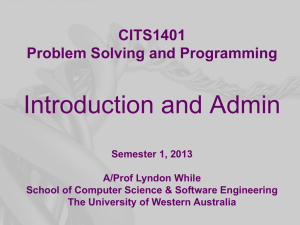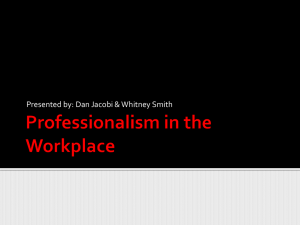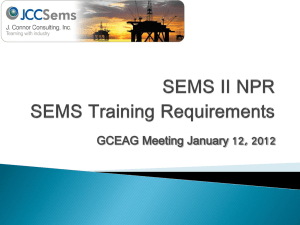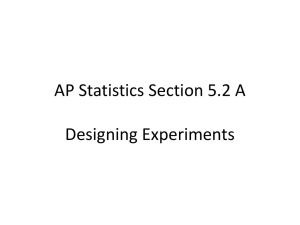Safety Induction - The University of Western Australia
advertisement
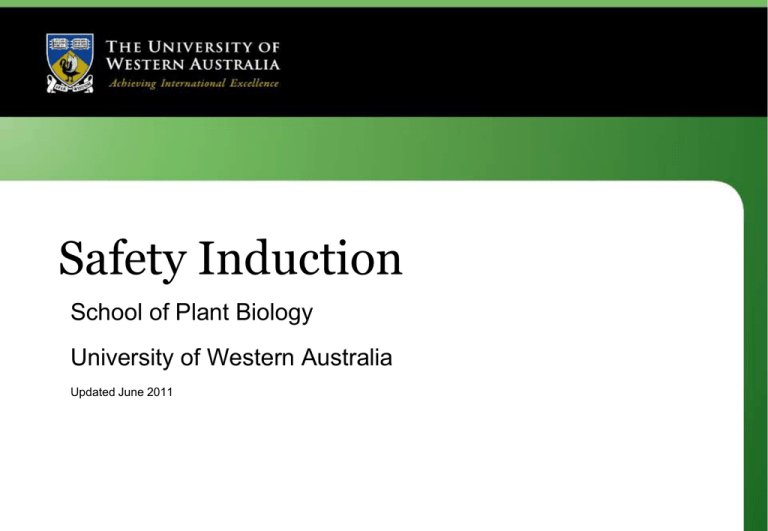
Safety Induction School of Plant Biology University of Western Australia Updated June 2011 Today’s Aims • Demonstrate UWA’s commitment to safety. • Impart safety knowledge to you. • Introduce key personnel in the School of Plant Biology. • Ensure your time at UWA is a safe, productive and enjoyable experience. Topics To Be Covered Today • General safety information – UWA safety policy – Some specific policies – Employee Assistance Program – Safety notes – Other work locations • Emergency procedures • Safety Personnel – – – – Head of School Building Wardens First Aid Officers Safety Personnel • Specific workplace procedures and requirements Occupational Safety and Health Policy http://www.safety.uwa.edu.au/policies/occupational_safety_and_health • Objectives: provision of a safe and healthy work environment for employees, students, contractors and visitors is not just a moral and legal responsibility but also a prerequisite for it to achieve its primary mission of conducting teaching, research and scholarship at the highest international standards. Occupational Safety and Health Policy http://www.safety.uwa.edu.au/policies/occupational_safety_and_health • Objectives • Responsibilities • Application • ‘Duty of Care’ Occupational Safety and Health Policy http://www.safety.uwa.edu.au/policies/occupational_safety_and_health • ‘Duty of Care’ • Do not put yourself or others at risk • Follow all safety policies & procedures • Report all known or observed incidents, injuries & hazards Policies, Procedures and Guidelines http://www.safety.uwa.edu.au/policies/induction?p=6859 • Management • Incidents & emergencies • Waste management • Hazard management – – – – Chemical Biological Physical Ergonomic Smoking Policy http://www.safety.uwa.edu.au/policies/smoking Smoking is prohibited in: – – – – AS of Jan 1 2012, entire campus is non-smoking All University controlled buildings Major thoroughfares and pathways Within 5m of access points to buildings such as doors, windows, near air-conditioning vents & ducts – Substantially enclosed courtyards. e.g. Social Sciences and Arts building courtyards – All University vehicles and boats underpinning principle being that non-smokers shall, as far as is practicable, not be subjected to smoke inhalation Safety and Health Issue Resolution Process Issue develops Notify immediate supervisor Issue unresolved S&H Rep and HOS notified Issue unresolved Safety and Health Office notified Issue unresolved Referred to the University Safety Committee Issue unresolved WorkSafe WA may be notified if there is a risk of imminent injury or harm Hazard Report Forms http://www.safety.uwa.edu.au/forms/hazard_identification_report_form • Presents an official means of documenting a hazard • Help to prevent possible incident or injury resulting from the hazard • Can be filled in by anyone, staff, student or visitor Incident Report Forms http://www.safety.uwa.edu.au/forms/incident • MUST be completed when an incident of any description has occurred. Injury does not have to have happened. • The first page MUST be filled in and sent to Safety and Health office within 24 hours of the incident. • Part 2 is to be completed by the supervisor or SSO or S&H Rep or a combination. This then is to be forwarded to the Safety and Health office as soon as completed. • For electrical incident, you must ring UWA electricians immediately 2036 Workers Compensation http://www.safety.uwa.edu.au/workers_compensation • A policy outlining workers compensation is available on the SHO website. • We hope you will never need this policy. Employees Assistance Program http://www.safety.uwa.edu.au/policies/eap • Counseling is available from OSA Group for staff members • Counseling available from the Student services for Undergraduate and Postgraduate students. Employees Assistance Program http://www.safety.uwa.edu.au/policies/eap The EAP provides assistance for issues such as: difficulties in relationships with work colleagues; coping with organisational change; mediation; harassment; stress with work; career issues; alcohol and substance misuse; relationships and family issues; emotional stress; concerns about children; financial and legal problems; grief and bereavement; health and lifestyle issues; trauma and critical incidents; coaching and mentoring for managers and supervisors. Equity and Diversity Services UWA http://www.equity.uwa.edu.au/ • Equity and Diversity Services promotes and supports UWA's vision to provide an equitable and inclusive environment for all staff, students and the broader community • Individual staff or students seeking advice about the University equity and diversity policy environment, or who wish to discuss a matter of concern that may fall within policy or the law, should initially make contact with an Equity and Diversity Adviser Electrical Safety http://www.safety.uwa.edu.au/electrical_safety • Please try not to bring in electrical equipment from home. • All equipment MUST be inspected by FM ($) or a competent person before use. • Bar heaters are not permitted due to the fire risks. • All heaters must have 1 hour timers fitted by FM. • Testing and tagging program. Screen Based Equipment http://www.safety.uwa.edu.au/policies/working_comfortably_with_computers • Ensure your computer is set up in the best possible way. • Make sure you have a break every 20 minutes. • Have a stretch. • Screen glare due to window directly behind computer. • UWA Safety Office can assist in workstation setup. Plant Biology Safety Notes • Located on the School’s staffnet web page http://www.plants.uwa.edu.au/staff/safety_and_inductions • A copy of the safety notes should be available in every lab. • These are for your safety, if there is something you think should be added, please bring it to our attention (make note at end of hardcopy manual; refer to School Manager or Safety and Health Representative, SHR) Work Site Specific Inductions • For your specific work area at UWA, you must undergo a site specific safety induction, e.g., laboratories, Plant Growth Facilities; • When working in conjunction with another department or institution, please follow their safety instructions. They are the experts in their field. Examples: UWA Field Stations; CSIRO; Hammersly Iron, DAFWA; Straits Resources; other UWA School’s, even Antarctica! Just covered: UWA OHS policy UWA Safety Policies & Procedures Resolving Safety Issues Hazard Reporting Incident Reporting Workers Assistance Workers Compensation School Safety Notes Site Specific Inductions ANY QUESTIONS?? Emergency Evacuation Procedures http://www.safety.uwa.edu.au/policies/emergency_fire_and_evacuation • Make sure you know the quickest way out of the building. • Then find the next quickest way. The first path might be the path into danger. Emergency Evacuation Procedures • If YOU activate the alarm, YOU must meet with the Building Warden. • YOU are the one with the most information about the situation. Emergency Assembly Points • Botany building, meet INSIDE the taxonomic gardens • Agriculture Central Wing building, meet either at the East muster point (Thurling Green) or in front of the CLIMA building Fire Extinguishers • DO NOT use unless you are very confident that you’re not going to hurt yourself in the process. • Use caution when operating the carbon dioxide extinguishers, your hand could freeze to the nozzle. • Always point at the base of the fire. • Practical training in the use of fire extinguishers is periodically offered by the Safety and Health Office. Types of Fire Extinguishers Three types available in Plant Biology; – Carbon dioxide, to be used on flammable liquids and electrical fires – Water, to be used on paper, wood, textile and fabric fires – Dry chemical powder, to be used on flammable liquids, flammable gases and electrical hazards Fire Extinguisher Use The use of the wrong type of extinguisher can be VERY dangerous. Please do not use them unless you are VERY sure of what to do. First Aid Kits http://www.safety.uwa.edu.au/policies/first_aid • First aid kits are available in each of the labs • Both field and snake bite first aid kits are available from the first aid officer, Hai Ngo in Botany building • Field first aid kits are located in the vehicles in Plant Biology School Safety Committee http://www.plants.uwa.edu.au/staff/safety_and_inductions/safety_committee School Manager and Safety Officer: Alan Luks (2541) Safety & Health Rep.: Greg Cawthray (1789/1748) Chairperson: Pandy du Preez (3863) Radiation Safety Officer: Guijun Yan (1240) Research Safety Rep.: Matthew Nelson (3671) Postgrad. Safety Rep.: vacant AHRI Safety Rep.: Mechelle Owen Kings Park Rep.: Rowena Long Glasshouse Safety Rep.: Robert Creasy Diving Safety Officer: now separate to PB Biological Safety Rep.: Patrick Finnegan (8546) Field Safety Rep.: Hai Ngo (3598) Chemical Safety Rep.: Greg Cawthray (1789) UWA Safety Office Rep.: Peter Carlyon (7934) First Aid Rep : Bonnie Knott (2206) (1512) (8549) Safety Management Structure Head of School Prof Hans Lambers *Safety Rep. Greg Cawthray Safety Committee Members *School Manager *School Safety Officer Alan Luks All Supervisors All Staff & Visitors All Students PB Safety Personnel Prof. Hans Lambers *Head of School Mr. Alan Luks *School Manager *School Safety Officer *Building Warden (Central Wing) Mr. Greg Cawthray *Safety & Health Rep *Chemical Safety Officer *Field Safety Officer *Building Warden (Botany) PB Safety Personnel Dr Guijun Yan *Academic Rep *Radiation Safety Officer Dr Patrick Finnegan *Biological Safety Officer Mr Robert Creasy *Plant Growth Facilities *First Aid Officer (PGF) PB Safety Personnel Mr. Hai Ngo *Field Safety Officer *First Aid Officer (Botany) Dr Matthew Nelson *Research Safety Rep. Ms. Mechelle Owen *AHRI Safety Rep PB Safety Personnel *Postgraduate Safety Rep. (Vacant) Mrs. Pandy du Preez *Committee Chairperson *School First Aid Officer Ms. Bonnie Knott *School First Aid Officer Just covered: Emergency Procedures Evacuation Assembly Points Fire Extinguishers First Aid Safety Personnel QUESTIONS?? Specific Work Place Hazards • Each specific work area will have its own specific hazards. These SHOULD be discussed with you by your supervisor. • Specific lab hazards are indicated by signage on laboratory &/or office doors. • The PB Site Specific safety Induction covers these hazards and should be conducted with your supervisor as soon as is practicable. http://www.plants.uwa.edu.au/staff/safety_and_inductions Specific Work Place Hazards • Some broad issues will now be covered – – – – – – – – – – Biological Safety Radiation Safety Chemical Safety Laboratory and Hazardous Substances Field Work Safety Dive Safety Machinery and equipment Vehicle usage PPE Manual Handling Biological Safety http://www.safety.uwa.edu.au/biological_safety PB Biological Safety Officer: Patrick Finnegan Biologicals of concern • Plant infectious / pathogenic agents • Animal infectious / pathogenic agents • Genetically modified / transgenic organisms Biological Safety • You must meet with Patrick Finnegan during the PLANNING of any work that will require – the importation of any biological material (not just organisms) OR – The use of a Genetically Modified Organism Radiation Safety http://www.safety.uwa.edu.au/radiation PB Radiation Safety Officer: Guijun Yan •All radioisotope users at the University are required to have attended and passed the Unsealed Radioisotope Handling Course within the first year of using radioisotopes, and preferably prior to starting such work. •Neutron Moisture Probe (Nuclear moisture density gauge). •Personal radiation monitors are required to be worn by all persons handling radioisotopes. •Please see Guijun Yan, to find out which laboratories are registered for use of radionucleotides. •All procedures involving radioactive materials at UWA requires the user to have completed a protocol application before commencing the work. Chemical Safety http://www.safety.uwa.edu.au/about_chemical_safety PB Chemical Safety Officer: Greg Cawthray • Comprehensive Lab Safety covered by compulsory UWA one day course • Material Safety Data Sheets (MSDS) • Safety and Risk Phrases (R&S phrases) • Chemical labelling • Chemical spillage • Waste disposal Labs and Hazardous Substances What Is an MSDS? http://www.safety.uwa.edu.au/about_chemical_safety/chemalert • It is a document that contains all the information you would need on any particular chemical. – Includes PPE, storage, handling, lethal dose, safety hazards. • Can be obtained via ChemAlert, from the supplier if you are purchasing the chemical from them for the first time, or upon request. • Hard copy should be kept in the laboratory where used. Labs and Hazardous Substances Labeling Chemicals http://www.safety.uwa.edu.au/about_chemical_safety/labelling_chemicals • Full information on chemical labels is required by WorkSafe WA. • Required for decanted chemicals. • Diamond labels can be obtained from Safety and Health Reps or the School Safety Officer. • Labels can also be generated with ChemAlert. Chemical Hazard / Spill / Gas Leak Raise the alarm Ensure immediate safety of everyone Treatment of serious injuries takes precedence over containment and decontamination Evacuate immediate area Report to supervisor and safety personnel Restrict unnecessary movements Turn off air conditioning (gases, vapours) Barricade and label Clean up / decontaminate (two persons) Report incident Labs and Hazardous Substances Waste Disposal http://www.safety.uwa.edu.au/about_chemical_safety/chemical_waste_collection • UWA now has campus wide waste collection coordinated biannually by the Safety Office, usually in Feb and June • Use of this service consolidates costs associated with overheads of collection, please make use of this service • Many waste chemicals can not to be disposed of down the sink. They should be treated or labelled fully and stored in an appropriate place to await disposal. • When in doubt ask the Chemical Safety Officer • Dispose sharps, biological hazards as per policy. Field Work Safety http://www.safety.uwa.edu.au/policies/field_work PB Field Work Safety Officers: Hai Ngo and Greg Cawthray •All people who undertake field work are required to submit a field work plan for approval by the HOS one week before the trip. (Field Work Procedures in Rural and Remote Areas) •If the use of a 4WD is required for off-road use, people must undertake the UWA 4WD course or similar course approved by UWA (e.g., Worsley on-site training; Shawsett). •Use of any UWA vehicle requires the user to be conversant with the appropriate policy (Use of University Vehicles). •Driving in remote locations is covered by UWA policy, and again people undertaking this work must be familiar with the policy (Driving in Remote Locations). Dive Safety http://www.safety.uwa.edu.au/policies/diving_and_boating PB Dive/Boat Safety Officer: Contact UWA Safety Office •All people who undertake diving and/or work with boats must converse with the Dive Safety Officer to assess your qualifications. Machinery and Equipment • No matter what you are asked to use in the course of your study, please ensure you are given full instructions for safe operation. Vehicle Use http://www.safety.uwa.edu.au/policies/use_of_university_vehicles • Many vehicles types are utilised. Please ensure that you have the correct training and licenses before you operate any vehicles. • e.g., 4WD, boats, tractors • Use of any UWA vehicle requires the user to be conversant with the appropriate policy (Use of University Vehicles) PPE (Personal Protective Equipment) • PPE includes: – – – – – Gloves Safety glasses Fully enclosed footwear (especially in laboratories) Lab coats Ear protection • Please ensure your PPE is maintained and USED Manual Handling http://www.safety.uwa.edu.au/policies/manual_handling • Assess the load you are about to lift • Get help, or a trolley, if you need it • Bend your knees and lift with your legs • Keep your back in a neutral position (not straight) • Keep the load close to your body • Don’t twist while holding a heavy load • Free course offered by UWA SHO Security http://www.security.uwa.edu.au/ • Botany building is locked outside the hours of 8am to 5.15pm Monday to Friday. • FNAS Central Wing building is locked outside the hours of 7:30am to 6pm. • Please ensure you keep the doors locked if you are here outside these hours. • Personal items are not covered by UWA insurance for theft from offices • Security staff can escort you to vehicle after hours, call X: 3020 Insurance http://www.safety.uwa.edu.au/insurance • Volunteer Workers Insurance • Corporate Travel Insurance • Student Personal Accident Insurance • Motor Vehicle Insurance • 457 Visa Insurance • Industrial Special Risk (University Property) Insurance • Marine Hull Insurance • Transit Insurance • Public Liability After Hours Register • NO chemical procedures &/or handling hazardous goods to be done after normal work hours • If you are here outside the hours of Monday to Friday 7.30am to 6pm, please fill in the after hours register • Also to be filled in at all times on weekends • The information is there to assist emergency personnel after hours, as they will know where to look for you • The information required is – – – – Name Location Time in Time out Staff ID Cards • If you are here outside of business hours, please carry staff ID card. Security can ask for this at any time on their rounds. • Staff or student cards are also the swipe card you need to get into certain buildings. It is also your library photocopy card. Certificates and Qualifications • Do you need any specific training? – – – – – – – – – – Manual handling (on demand, free) First Aid (external, $90 to $140) 4WD (Full Day, internal $150 to external $270pp) Lab Safety (Full Day, $40pp) Gene Technology (see Patrick Finnegan) Radiation and Moisture probe, (3 days, see Guijun Yan) Laser Safety (1/2 day, $20) Boat Handling (see Gary Kendrick) Fire awareness and extinguisher training Anything else you can think of? Safety Related Training 2010 http://www.safety.uwa.edu.au/courses • Laboratory Safety Course (1 day, Friday 22nd July ) (Compulsory for all lab based research) http://www.safety.uwa.edu.au/courses/lab • ChemAlert General User training (2 hr, on demand) http://www.safety.uwa.edu.au/courses/chemalert_basic_training • Unsealed Radioisotope Handling Courses (3 days, Monday 18th July) http://www.safety.uwa.edu.au/courses/radioisotope • Warden Training Course (3 hours, Monday 3rd October 2011) http://www.safety.uwa.edu.au/courses/warden • Warden Refresher Training Course (1 hour, Monday 3rd October 2011) http://www.safety.uwa.edu.au/courses/warden_refresher • Senior First Aid Course (2 day, TBA) http://www.osds.uwa.edu.au/about/programme?workshop_id=499 • Safety and Health for Managers and Supervisors (2*1/2 days, over 21/22 June 2011) http://www.safety.uwa.edu.au/courses/Safety_and_Health_for_Managers_and_Supervisors • 4WD Driver Training (refer to website) http://www.safety.uwa.edu.au/courses/4wd Health • A healthy body is less prone to injury • Some suggestions to help you on your way » » » » » » » Walk on campus, don’t use a vehicle. Use the stairs, not the lift. Join the gym. Go for a stroll along the river in lunch break. Join Plant Biology Yoga classes!! Go fishing at lunchtime on the river…beautiful! Attend Friday Morning Tea and meet other staff & students in the School. Final Thoughts • “DUTY OF CARE” • Think about what you are about to do. • Develop good housekeeping habits. • Observe and be aware • In all areas at all times take notice of (and obey) all signs and directives – they are there for your safety. Just covered: WAY TOO MUCH!!! ANY QUESTIONS??
